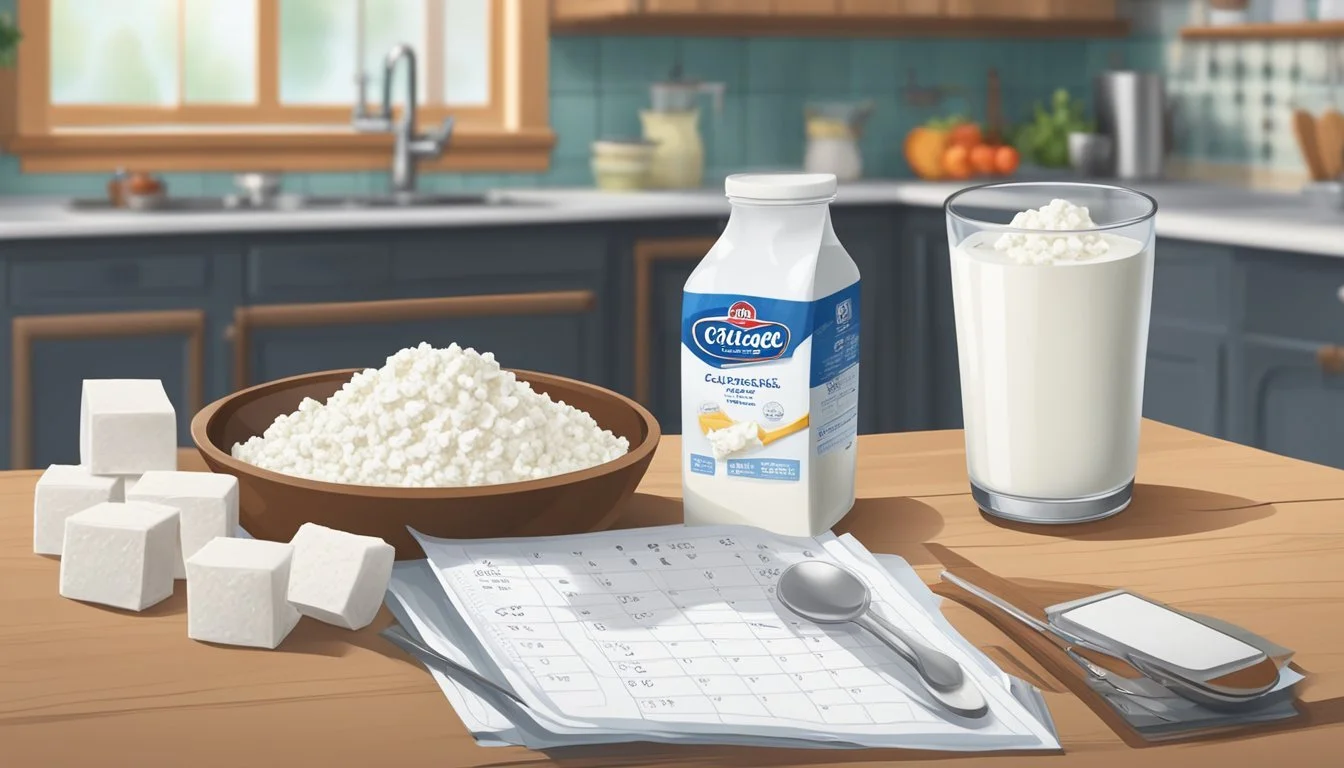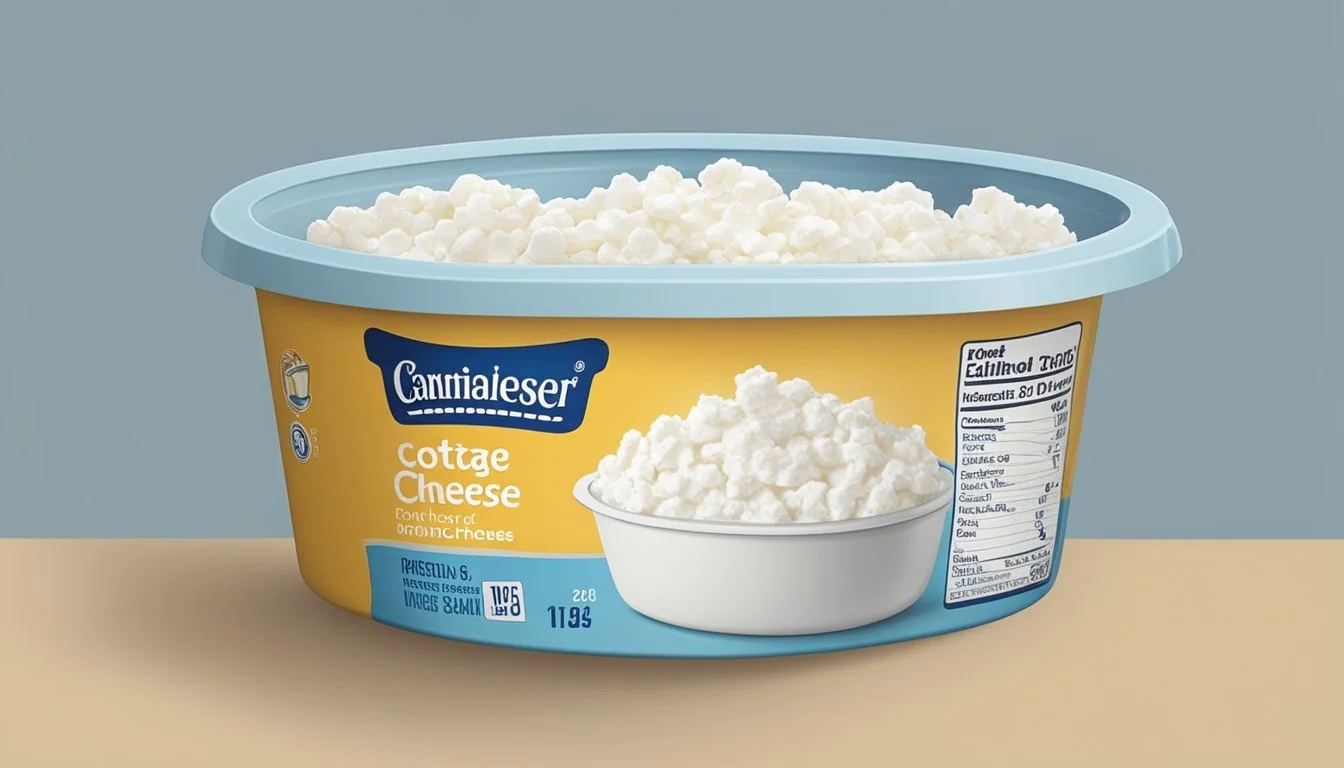Does Cottage Cheese Go Bad?
Understanding Shelf Life and Spoilage Signs
Cottage cheese is a staple in many diets due to its high protein content and versatility. However, like all dairy products, it is perishable and can indeed go bad, posing safety and health concerns. When stored properly in the refrigerator at or below 40 degrees Fahrenheit, unopened cottage cheese (What wine goes well with cheese?) generally remains safe to consume for about two weeks. It's vital to pay attention to the "use by" date provided by the manufacturer, as this indicates the last day the product is expected to retain its peak quality.
Once the container is opened, the shelf life of cottage cheese is substantially reduced. It should be consumed within a week, always ensuring the container is sealed tightly after each use to prevent spoilage. If the product has surpassed its date or exhibits signs of spoilage such as an off smell, discoloration, or the presence of mold, it is no longer safe to consume and should be discarded promptly. It's essential to trust one's senses; if something about the cottage cheese seems amiss, it's best to err on the side of caution.
In today's culinary landscape, food safety is paramount and understanding the shelf life of ingredients like cottage cheese is key to maintaining good health. Regularly checking the condition of perishable products before consumption ensures that one enjoys not only the taste but the benefits of fresh, safe dairy products.
Cottage Cheese Fundamentals
Cottage cheese is a fresh dairy product known for its creamy texture and mild flavor. It's a versatile ingredient that can be used in a variety of dishes or enjoyed on its own.
What Is Cottage Cheese
Cottage cheese is a type of fresh cheese curd product characterized by its loose, creamy, and lumpy texture. Unlike aged cheeses, it doesn't undergo a ripening process to develop flavor. Instead, it retains a fresh and mild taste. The cheese is made by adding an acid to pasteurized milk which causes curd formation. The curds are then washed to remove the whey, resulting in a lower lactose content, and left with a high moisture content that contributes to its creamy consistency.
Nutritional Profile
Cottage cheese is highly regarded for its nutritional benefits, providing a rich source of protein and essential nutrients. It's low in fat and carbohydrates, making it a favored option for individuals seeking a healthy, balanced diet. The nutritional profile of cottage cheese varies depending on the level of milkfat used during production, with non-fat, low-fat, and regular varieties available.
Nutrient Amount per 100g Calories ~98 Protein ~11.1g Total Fat ~4.3g (for 4% milkfat) Carbohydrates ~3.4g Calcium ~83mg
Cottage cheese is particularly rich in casein, a slow-digesting protein that helps with muscle recovery and satiety, making it a popular choice among athletes and those following a fitness regimen.
Shelf Life and Spoilage
Cottage cheese, a popular dairy product known for its creamy texture, does have a finite shelf life, and like any perishable food, it can spoil. Both the shelf life and spoilage are contingent upon storage conditions and adherence to dates printed on packaging.
Understanding Expiration Dates
Sell-by Date: This date indicates the last day the product should be sold. Consumers can expect that cottage cheese will remain fresh for a short period beyond this date, provided it has been stored correctly.
Unopened Cottage Cheese: Typically lasts for 5-7 days past the sell-by date when refrigerated properly at or below 40°F.
Opened Cottage Cheese: Once opened, it should be consumed within 5-7 days for the best quality.
It is critical to note that these time frames are for optimal quality rather than safety, and one may be able to consume cottage cheese slightly beyond these periods if it has been stored adequately and shows no signs of spoilage.
Signs of Spoilage
Cottage cheese's spoilage is visibly and olfactorily noticeable. Consumers should look for:
Discoloration: Any yellowing or development of green mold spots indicates spoilage.
Off-odor: A sour or unpleasant smell is a clear sign that the cottage cheese is no longer safe to eat.
Texture Changes: If the cheese separates, becomes slimy, or excessively watery, it has likely gone bad.
At any indication of spoilage, the cottage cheese must be discarded to avoid potential foodborne illness.
Proper Storage Techniques
Ensuring that cottage cheese stays fresh and safe for consumption involves specific storage techniques focused on temperature control, preventing freezer burn, and minimizing air exposure.
Refrigeration Best Practices
Temperature Settings: The refrigerator should be set below 40°F (4°C). It is ideal to position cottage cheese on lower shelves and towards the back of the fridge where the temperature is more constant.
Location in the Fridge: Avoid placing cottage cheese near the door to prevent exposure to fluctuating temperatures.
Freezing Cottage Cheese
Preparing for Freezing: Before placing cottage cheese in the freezer, it should be packed in a way that minimizes exposure to air.
Wrap with Foil: Cover the cottage cheese with aluminum foil or place it in a freezer-safe bag.
Label and Date: Label the packaging with the freezing date to track how long it's been stored.
Textural Changes: Be aware that freezing may alter the texture of cottage cheese, making it grainy. It's still suitable for cooked dishes.
Airtight Containers and Seal Methods
After Opening: Once the foil seal is removed from a package of cottage cheese, it should be kept in an airtight container if the original lid doesn’t seal properly.
Transfer: If necessary, transfer the cheese to a container that can be sealed tightly.
Seal Enhancement: To improve the original container's seal, one could place a layer of cling film over the opening before applying the lid or use a rubber band to secure the plastic lid firmly.
Recognizing Bad Cottage Cheese
Identifying spoiled cottage cheese is crucial to ensure food safety. Key indicators include changes in smell, taste, texture, and appearance, all of which signal that the cheese should not be consumed.
Smell
Spoiled cottage cheese often emits a distinctly sour or rancid odor which differs from its naturally mild, slightly tangy scent. An offensive, yeasty smell should alert the consumer to avoid eating the product.
Taste
It is generally not advised to taste cottage cheese if spoilage is suspected. However, if it happens, a sour or unpleasant taste distinctly signifies that it has gone bad.
Texture
The consistency of fresh cottage cheese is creamy with small, firm curds. If the texture becomes watery, lumpy, or develops an unusual graininess or chunkiness, it's likely spoiled.
Appearance
Visual cues are a reliable method to assess quality. Cottage cheese should be uniformly white with a moist surface; any discoloration or visible mold clearly indicates spoilage.
Health and Safety Considerations
When considering the health and safety implications of cottage cheese, it is crucial to understand the risks associated with spoiled products and the measures to prevent foodborne illnesses.
Risks of Consuming Spoiled Cottage Cheese
Spoiled cottage cheese poses various health risks due to the potential growth of harmful bacteria such as Listeria, E. coli, and Salmonella. The presence of these bacteria can lead to foodborne illnesses, with symptoms ranging from mild gastrointestinal discomfort to severe, life-threatening conditions. Toxins produced by these microorganisms can remain in the cheese, and consumption of these toxins can lead to illness even if the live bacteria have been killed. Signs that cottage cheese has gone bad include:
Presence of mold or discoloration
An overly sour smell or a change in aroma
A slimy or altered texture
Preventing Foodborne Illness
Preventing cross-contamination and proper storage are key in preventing foodborne illness. Cottage cheese should be stored at a safe temperature below 40°F to inhibit bacterial growth. Once opened, it's recommended to:
Store with a tight-fitting lid
Consume within a week to ensure freshness
Adhering to expiry dates and observing changes in the product are essential safety measures. Proper hygiene and handling practices, such as using clean utensils and avoiding the mixture of cottage cheese with other food items, help prevent cross-contamination.
Usage Tips
Cottage cheese is a versatile dairy product that can enhance the flavor and nutritional value of various dishes. It's important to use it optimally in recipes, ensure its freshness when consuming, and understand how it can substitute other dairy ingredients.
Cottage Cheese in Recipes
Cottage cheese can be a delicious addition to an array of recipes. It lends a creamy texture to soups and can be incorporated into salads for a protein-rich ingredient. Cooks often use it in lasagnas and other baked dishes where it holds moisture and adds complexity.
Freshness in Consumption
Consumers should prioritize freshness for the best taste and safety. Once a container is opened, it's advisable to consume the cottage cheese within 5-7 days, smelling and visually inspecting before use to ensure it hasn't spoiled. If any signs of mold or sour smell are present, it should not be consumed.
Substituting for Other Dairy Products
Cottage cheese is a great substitute for other dairy products because of its texture and taste. It can stand in for ricotta in recipes, offer a healthier alternative to yogurt in breakfast bowls, and even replace brie in some instances. When using leftovers, one can blend cottage cheese for a smoother consistency to mimic creamier cheeses.
Common Questions and Concerns
In understanding cottage cheese's shelf life, it's essential to recognize its unique properties compared to other dairy products, the implication of texture changes, and the nuances of storing leftovers effectively.
Differences from Other Dairy Products
Cottage cheese is a soft, white cheese with a mild flavor. Unlike hard cheeses, cottage cheese has a higher moisture content, which can impact its longevity. Texture and consistency are crucial indicators of quality. While hard cheeses may last longer even when they start to dry out or mold, cottage cheese should be consumed more promptly due to its susceptibility to bacterial growth.
Dealing with Separation and Texture Changes
A common trait of cottage cheese is the separation of liquid, resulting in a watery layer on top. This is often a harmless occurrence and can be resolved by simply stirring the cheese. However, changes in texture, such as becoming overly chunky or slimy, suggest spoilage. Once the consistency deviates significantly from the original state—smooth with small curds—consumers should exercise caution and consider disposing of the product.
Managing Leftovers
Storing leftover cottage cheese properly is essential to maintaining its safety and quality. It should be kept refrigerated at a temperature below 40°F, preferably on lower shelves where the temperature is most stable. Consumers should also transfer it to an airtight container if the original packaging is compromised. As for usage, incorporating leftovers into a dip or pairing with fruit are popular options, but one should always assess the cheese's condition before consumption.
Left Out: Never consume if left out for more than two hours.
Stored: Refrigerate at or below 40°F.
Leftovers: Use within five to seven days after opening for optimal quality.







